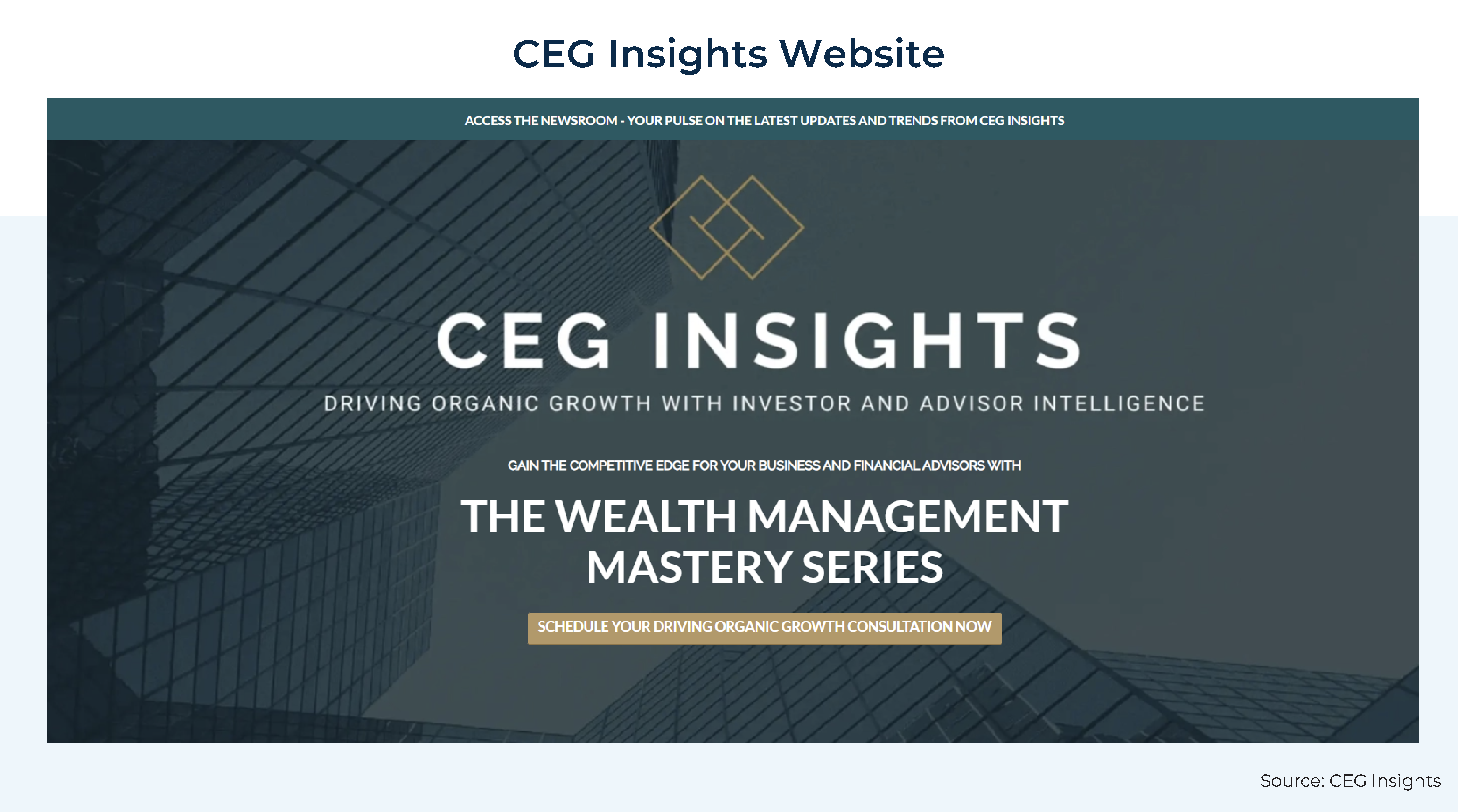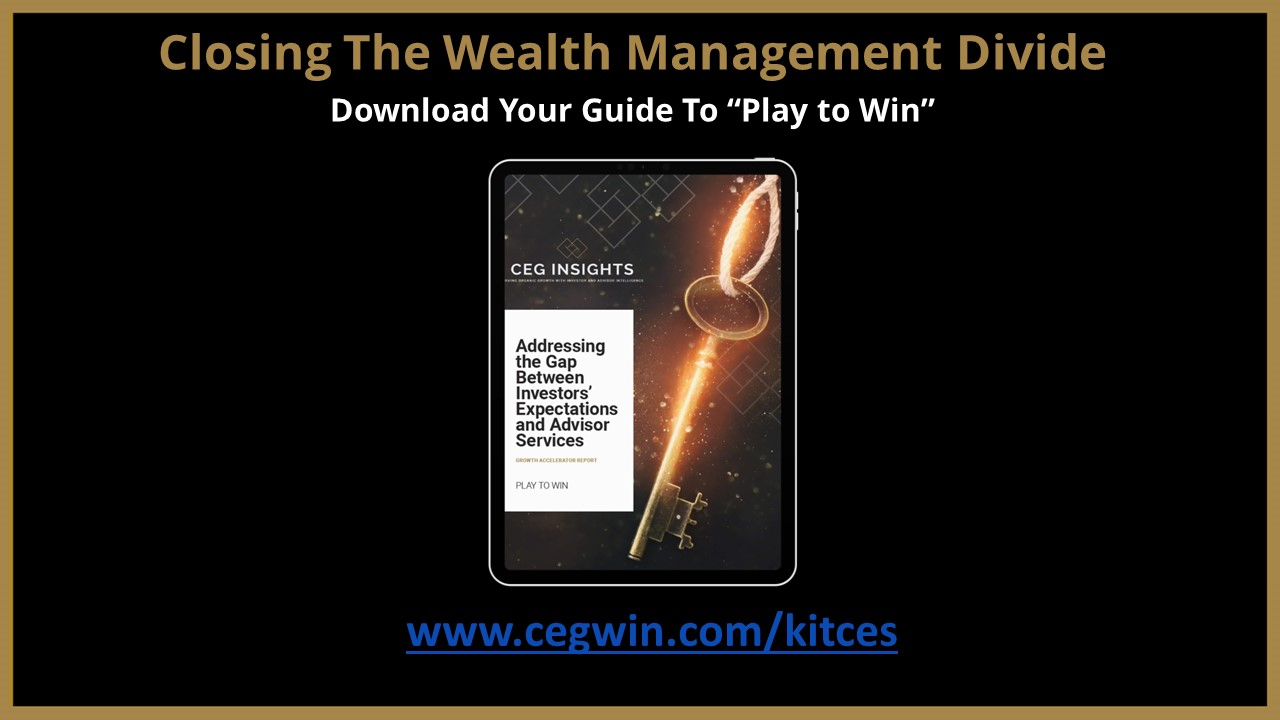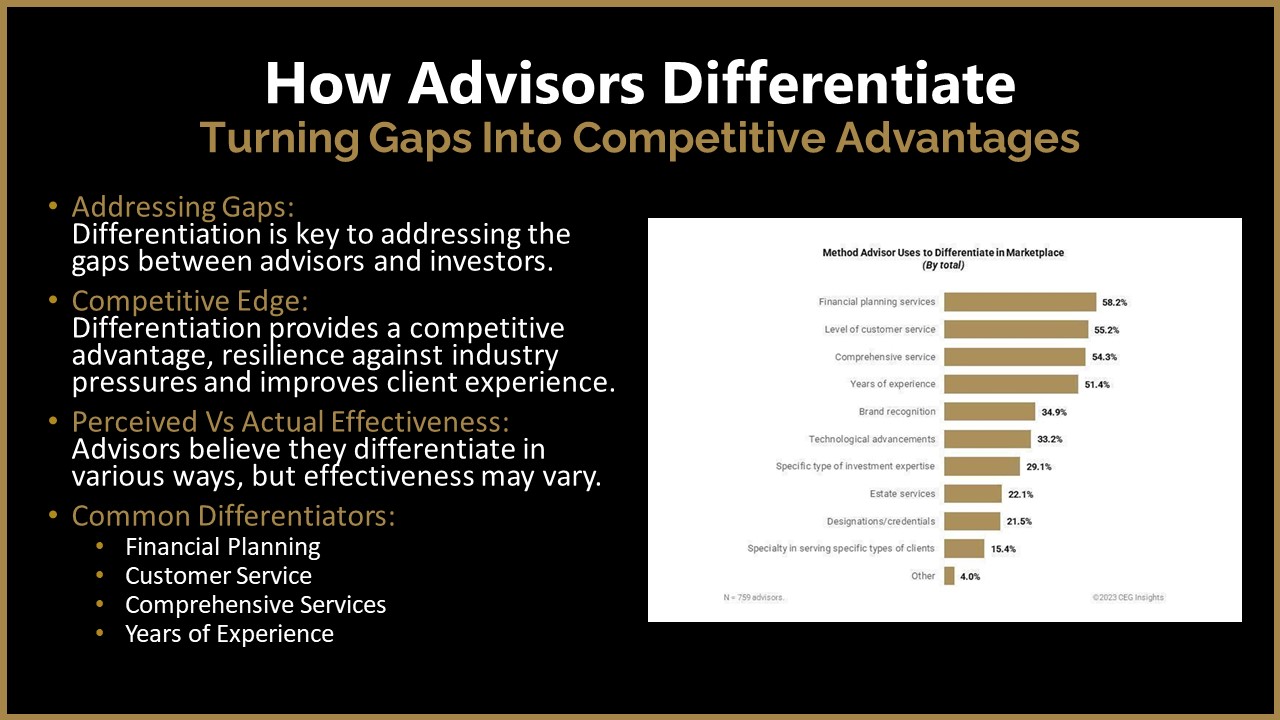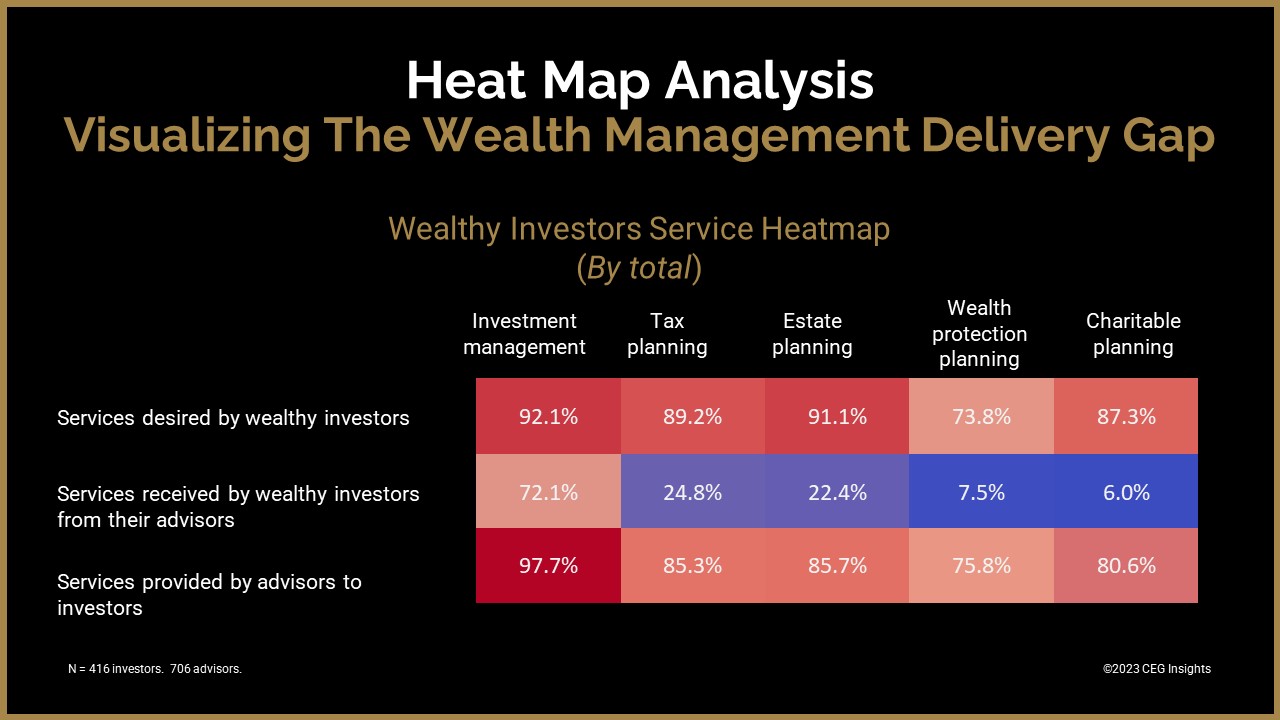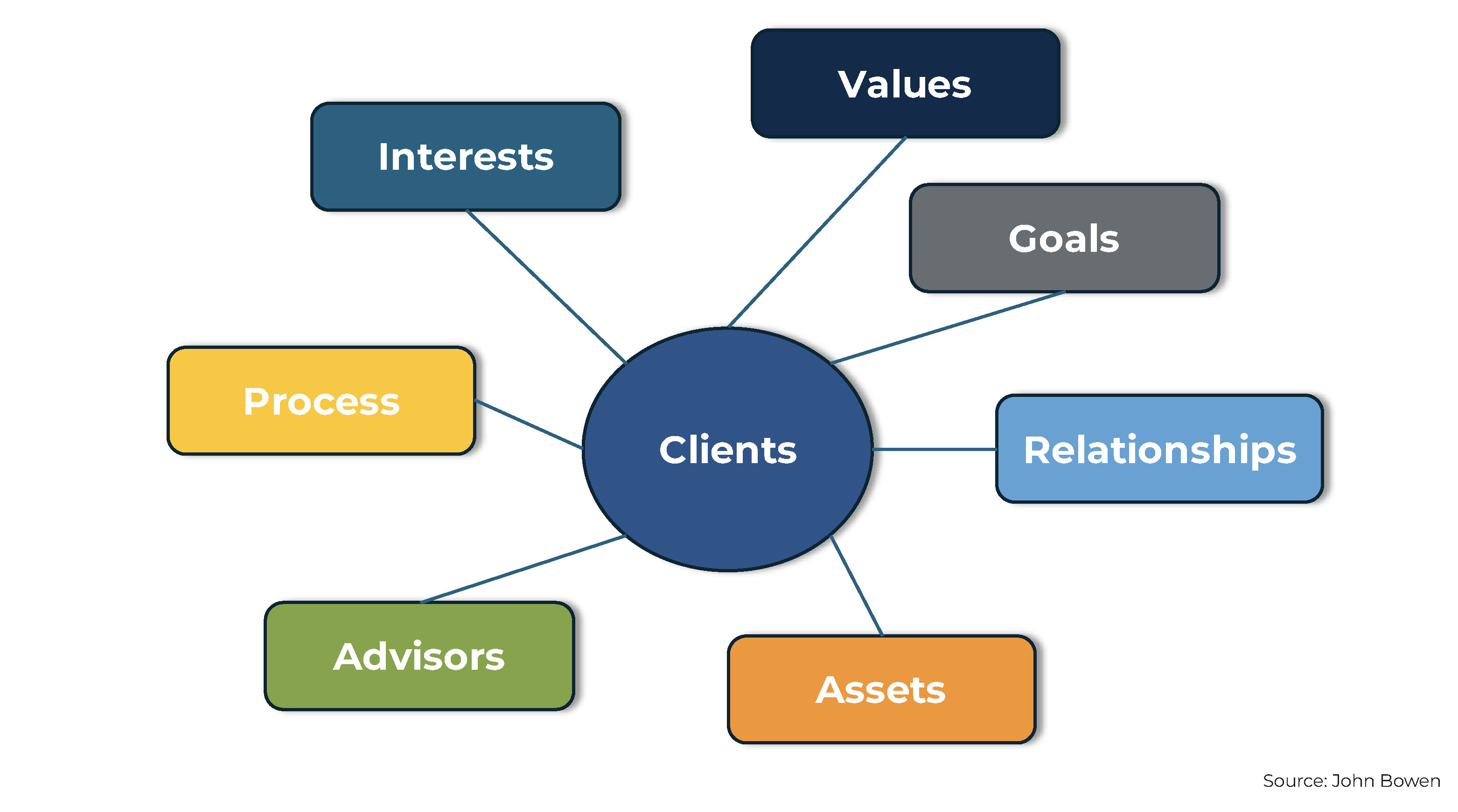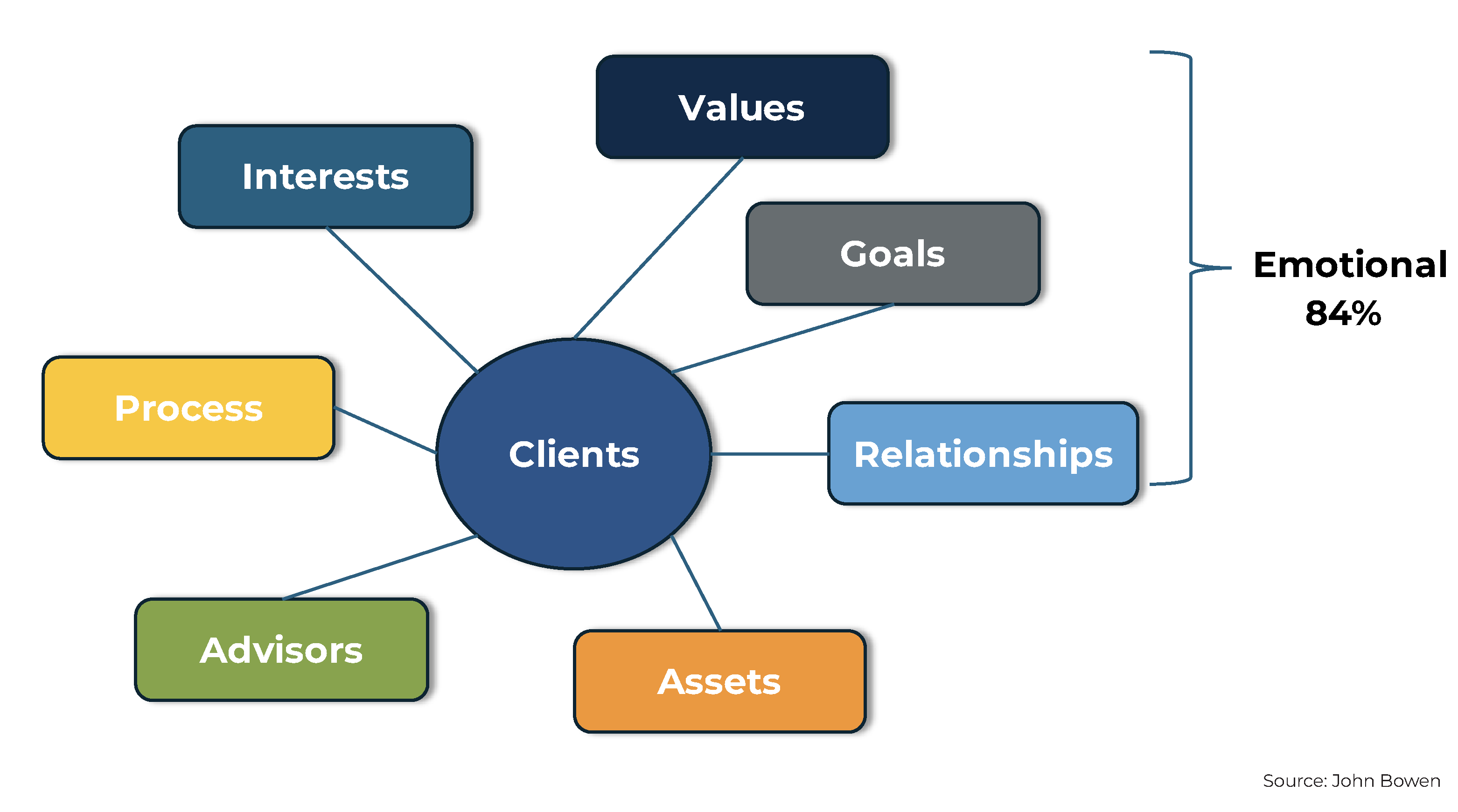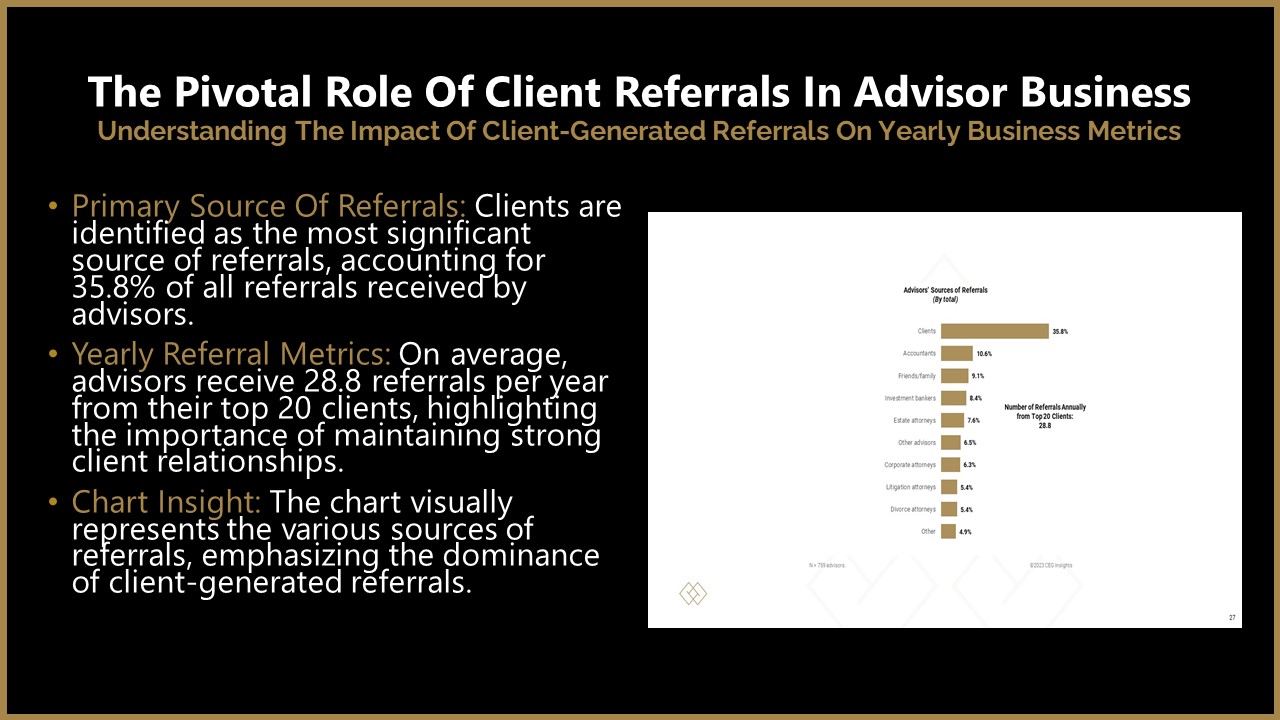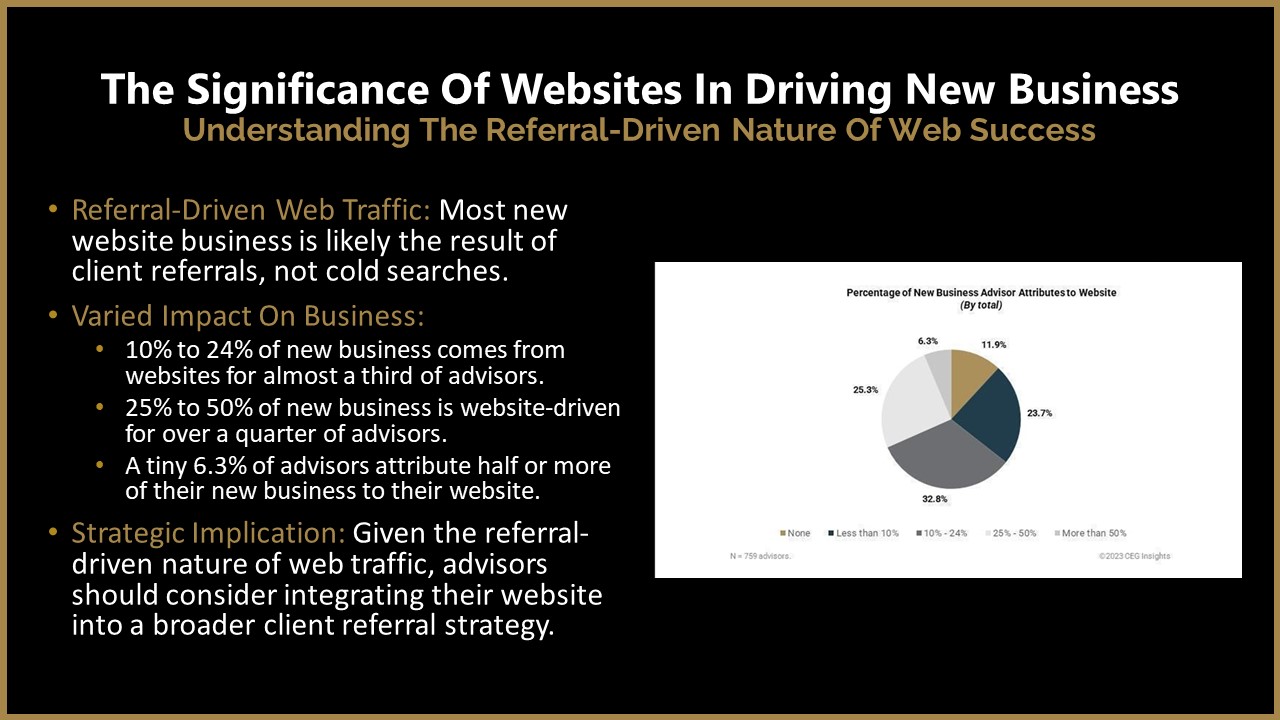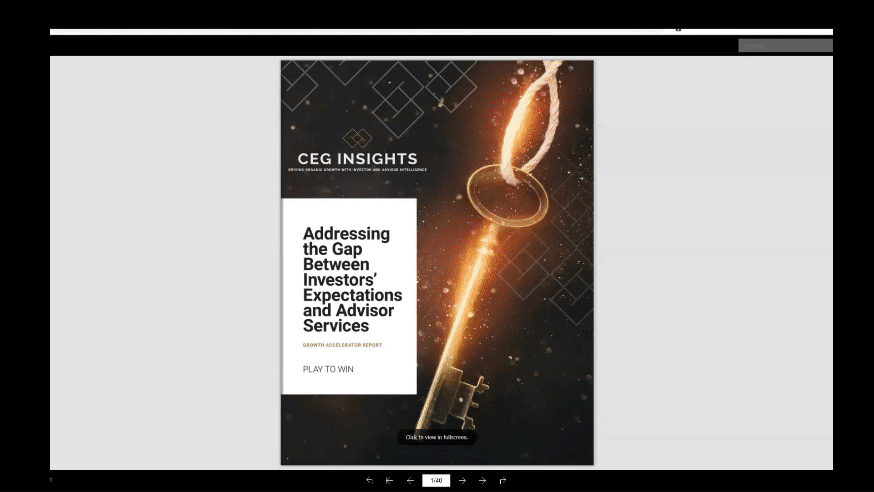Executive Summary
In the early days of wealth management, a financial advisor's value proposition was relatively explicit, typically focusing on a limited range of portfolio management activities (e.g., selling and trading) or on sales-oriented advice that centered on implementing insurance products. As the industry has evolved, though, the value offered by financial advisors, especially for High-Net-Worth (HNW) clients, has come to involve a far more comprehensive range of services in addition to traditional investment management practices, such as estate planning, tax advice, and charitable planning, all while using insights from financial psychology and behavioral finance to help clients stay on track with their long-term financial planning goals. While this shift has enriched the advisor's role, it has also introduced challenges in aligning the advisor's offerings with the nuanced needs of HNW prospects and clients.
In this 'hybrid' video-based article, Michael Kitces and John Bowen, CEO and founder of CEG Worldwide and CEG Insights (formerly Spectrem Group), dive into CEG's extensive data on the "gap" between the services that financial advisors actually offer to their clients and what HNW clients truly want from their advisors. The discussion highlights the often-misinterpreted needs of HNW clients and how advisors can ensure their services are aligned to meet their clients' expectations most effectively.
As a starting point, while the language that describes what prospective HNW clients want and what advisors offer may often sound similar, in reality, what each party actually means can be quite different. For example, an advisor may think of "risk management" in terms of life and property insurance coverage, whereas HNW clients may instead think of tax and estate-planning strategies as asset protection measures – particularly for the future wealth of their heirs. If clients and advisors approach issues with a fundamentally different psychology, then an advisor's 'comprehensive' advice may not address the client's actual problems. Even with the best intentions, this disconnect can ultimately damage an advisor's perceived value over time.
Fortunately, financial advicers can bridge these communication gaps in a few ways, starting with their discovery process. Foundational to understanding what a client will perceive as valuable advice is first having an understanding of their goals, relationships, and values. Identifying these principal elements before delving into the client's situational details of their finances can help the advicer address the issues truly of concern to the client. This approach not only tailors advice more effectively, but also serves as an impactful marketing differentiator in a competitive environment where many advicers describe themselves as having excellent customer service, comprehensive advice, and fiduciary standards, especially when the advicer is able to convey how their strategies address their clients' real problems – as the client understands them, which can be incredibly powerful!
Ultimately, the key point is that what most HNW clients actually want is an advisor who understands and can solve their unique problems… and that the value of such advice may go unrecognized unless an advisor is able to explain how their solutions align with the client's core values and goals. However, when an advicer prioritizes identifying and understanding the client's values and goals, they can more easily showcase the real value of their advice, leading to mutual success and long-term client satisfaction!
Show Notes
Full Transcript
Michael: Well, welcome, everyone. Welcome to a new kind of ‘article,’ a new kind of content approach here on Kitces platform, a new guest joining us today. This can be a little bit of a new, I guess, experiment for us, hopefully, a new series. If you like it, then give us good feedback around it. We're talking today around reaching more high-net-worth prospects, which I know most advisors at some point want to figure out, "How do I move a little further up market? It's nice to get paid a little bit more for your time and advice from people who have the financial wherewithal to be able to pay us a little bit more for our time and advice."
And so, my guest today is John Bowen. So, many advisors know John is CEO and founder of CEG Worldwide, which has taught and trained advisors around marketing into high-net-worth clientele for many years now. More recently, CEG bought Spectrem Group, which was a market research firm around how consumers engage with advisors, now CEG Insights. Putting out what I think is some really interesting data, because I love data, some really interesting data around what do affluent consumers actually care about when they're looking at advisors and trying to pick advisors, and so I thought like, "What a fun way to experiment this to say maybe we could just put some data on a screen and talk about some interesting numbers?" So, that's basically our golden lineup today, and just want to welcome John. Welcome to the Kitces platform and getting to nerd out with us a little bit on research data.
John: Well, Michael, you and I...first of all, appreciate the opportunity to share the nerding experience with you. We both have, for our whole careers, loved empirical research. And I've done it for many, many years, both as an advisor building a practice, a couple billion dollars, and then now the last 20 years doing coaching. And there's just so many insights. And the problem I always think about when I was an advisor that we're always in this entrepreneurial fog. We're trying to figure it out. You're providing some great...you got a great lighthouse. You're pointing the path. But the more detail we can have, the more powerful it is. And there's an opportunity to do well by doing well. So, I'm excited to be here today.
Michael: So, I think before we get in, because we're going to get pretty nerdy pretty soon here, there are going to be screenshares with charts. I promise there won't actually be any Excel charts – John has made them in a very nice polished chart – so, we're not going to look directly at spreadsheets. We're going to get nerdy on that in a moment. But, John, maybe just before we kick off, for folks who maybe know our Kitces platform but are a little bit newer to you, can you give us a little bit more perspective, I think, particularly around CEG insights and the study that you've done? And then, we'll start looking at...
John: Yeah, you can go to the website, CEG Insights, and I'll push a button and just put it up on screen. It's as you would expect, CEGInsights.com.
John: And this is really where we brought together the research that CEG Worldwide, our coaching organization, has been doing a couple of studies every year for the last 20 years and merged it with Spectrem, who world-class, as you were saying, Michael, world-class on really studying the affluent. And we said, "Why don't we go ahead and continue those studies on the affluent?" And we do 4 major segments, all the way up to about $25 million of investable that we do. And we're going to talk about one of them today that I just think is so eye-opening for everyone.
And then, we study the very high end, not family office, but all the way up to family office from $25 million and above. And we did a strategic partnership with... some of you know Strategic Coach, Dan Sullivan. Dan and I did a study of a little over 2,000 entrepreneurs. So, we're really diving in all this. There's eight studies each year for our corporate clients. But, Michael, part of working together here on this, we're going to make available to all your audience a report. We call them Play to Win on what we're going to talk about today. I always call it the wealth management gap. There's a difference between what the affluent want and what they perceive they're receiving. And this is going to keep us busy.
How Do Advisors Differentiate Themselves? [4:49]
Michael: That's an interesting way to frame the gap. And I know we'll get more into this in a moment. We're not necessarily talking about the gap between what wealthy investors want and what advisors are offering more along the lines of what affluent investors want and what they perceive they're getting, which has some implications over where that’s going.
John: Yeah, there's a difference because their perception may not be reality. It may not be the advisor's reality. But when we get into the data... and we're going to share with you the ability, and I'll just put it up. You can go to www.cegwin.com/kitces, and you can download the report. We're going to go and it has more than what Michael and I could talk about or geek out about today.
But one of the biggest surprise is, really, advisors are telling us they're doing what clients want. And it's exactly. But then, when you ask the clients, they're not perceiving it. Now, I don't think anybody's lying, but there's a difference in realities that we're going to talk about today that represent an opportunity not only for anybody who wants to move upmarket. There's a huge opportunity. But also for your own clients, it's kind of that offense-defense type thing that...and particularly in today's world, as technology is improving, AI... before Michael and I turn on the camera, we were talking about AI. And you've got to be able to add value. Average advisors, AI is going to take that very quickly. So, we've got to think through how can we create more value for whoever we choose to work with.
Michael: So, in that vein, so I want to get more into the gap in a moment, but I actually want to start the conversation because I know you have some interesting charts and data around how advisors just try to differentiate themselves to attract in the first place. We can't get into the services gap between delivery and experience until we just get to, what are we even trying to offer to differentiate ourselves in the first place? So, I'm wondering, maybe we can start there of... I know you have some data around, how do advisors try to differentiate themselves?
John: Yeah, let's just shoot that up, Michael. This is one of the things we've got to be careful, everyone, about… We all look the same. I got to tell you, I had a speaker come to an event, 200 of our top clients. And this is a number of years ago, but he took pictures off LinkedIn of everybody. And for the guys, the only difference was whether they had a red tie or blue tie type thing. It might be a little different now. Some will be without tie. The ladies weren't that much different. And so, when Michael and I talk about different... Oops, let me hit the right button. When we talk about differentiating ourselves, it's really this here, is we 0 in on financial planning.
Michael: I was reading what these numbers say. So, 58% of us differentiate by the fact that we offer financial planning, frankly, and that's advisors at large. You are our Kitces readership. That's probably an even higher percentage. 55% of us are differentiating on the level of our customer service, 54% by our comprehensiveness. So, frankly, there are 2 things that strike me about this, just looking at it. The first is, so, basically, we're all saying we provide financial planning and have great service, which starts to feel not very differentiated because we're all saying it. And, B, literally, we're all saying it: 55% of us are saying we've got better than average service. 55% of us can't be above average.
John: Well, it's so funny because when we start thinking of how we differentiate ourselves, imagine you go into any kind of business and they say, "We differentiate ourselves by giving good service." That's table stakes. Okay, I'm coming to you as a financial advisor, you do financial planning: table stakes. I have comprehensive service. Well, I would hope so type thing. These are not – oh, and “I've been in it for a long time." Okay, great. These are not powerful marketing differentiators at all.
Michael: So then what is, because I know you've done some work of...the advisors who are actually getting a little bit more traction, what are they offering that's actually different, say in the last...?
John: Well, when we started looking at it, and we're going to get into it when we see the drivers, but they're looking...what people want are exclusive services. And depending on the market, and we're serving a wide range, long-term planning, obviously, for the ultra-wealthy, that's not going to be...
Michael: What is long-term planning in this context? My brain goes to long-term care insurance. I don't think that's what we're talking about.
John: No. One of the things we're starting to think about is longevity. And most of us like life, and we want to stick around longer. So, really planning through that longevity wellness. Number 1 on the personal concerns, there's usually 2. Depending on the partners, they're within 1%. I care about my spouse more, their health, and then mine type of thing. Sometimes it flips, but they're always...
Michael: So, this is a very like health, wellness, longevity kind of orientation.
John: Yes. And then, we start thinking of we care about families, the family financial education. And as we continue down this, one of the things I want you to look at, and this is when we break it out in the report by generation, too. So, if you're in my group of baby boomers, quite honestly, socially responsible investing is not a big deal. You're in the millennials, big deal. So, you want to think through your audience, who you're going to do. What we're really seeing when we start going through all of these, though, is the people when we segment by income, what they're doing is they're providing advice beyond simply investing. And many of them are positioning as virtual family offices with technology today being able to provide a single-family experience, but virtually. And...
The 5 Value Propositions Financial Advisors Can Offer Prospects [11:22]
Michael: What does that mean in the context of high-net-worth clients? Like virtual family. I know our industry use. I feel like basically, virtual family offices, we have comprehensive planning with great service, and we can use Zoom.
John: At a minimum, we define it as 5 things. You're going to help them make smart decisions about their money, the investment side.
Michael: I do that.
John: Second is mitigating taxes. You're going to be very thoughtful on mitigating taxes. The third thing is you're going to take care of their heirs. And this is whether with the exclusions and so on, they have to pay estate taxes or not. People are concerned that most families are dysfunctional. I don't know, Michael, your family. I do know mine. I know many others. And taking care of the heirs means more than just avoiding taxes and then asset protection.
Michael: Taking care of the what? Errors?
John: Heirs.
Michael: Heirs, heirs.
John: Yeah, beneficiaries.
Michael: Heirs. Got it.
John: Yeah. And then, the asset protection side, one of the things is you get wealthier. There's nothing worse than going down. I go up very gracefully that going down not so good, and then charitable. And then, really what we're seeing most people doing, the virtual family office, excuse me, they go ahead and they understand this health and wellness, so they're including some kind of longevity concierge relationship. Remember, with virtual, you don't have to provide all the expertise, but you have to be kind of the franchise player putting it all together for them, bringing these experts together.
Michael: I'm struck by this list. So, it's just the comprehensive advice, that's the starting point. But most of us do that. Taxes with the asterisk, so like these get a little more complex around the tax issues when you start adding several zeros to the balance sheet. Take care of my heirs, so that's family financial education. That's intergenerational planning. That's like how much money do I leave my kids and not ruin them? And how do I actually transfer it to them? Because only one wants to be in the business, the other doesn't, and all that stuff.
John: And what was eye-opening on this nerding off stuff is how young they want you... They want you to start talking to their kids certainly before 26, but as teenagers. And it's really important to them. And obviously, many advisors are not doing that type. So, they're very concerned about the kids and their beneficiaries that they have.
Michael: So, I feel like a lot of advisors will say like, "Sure, we do some occasional workshops for children of clients. If Johnny wants to come in and open his first Roth IRA, I'll help him out." Does that count? Or if we're talking virtual family office, are you at some level beyond what we say we're doing when we're like, "Sure, I'll help your kids," sort of that stuff?
John: Well, one of the things that's really unique that we're finding in the most successful financial advisors, and we teach it in our coaching programs, is being able to have deep discoveries. So, one of the key things is in financial services, we can provide all kinds of expertise. I mean, Michael, your database, you've got so much, you've got all these experts. I have all these experts. We can do all amazing things. A novel idea is to ask your client what they're most concerned with and really understand what their values are, what their goals are, really what are the important relationships before we even get into the asset liability side. And what we find in virtual family office, and we teach in our coaching programs, really identify what are...I call it the vital few, the few things that you can do right away. Because when I was a financial advisor, I can still remember there was a time when I did 200-page gold leather books.
Michael: Oh, we had the punch device so we could put the binding on. Yeah.
John: Yeah. It is embarrassing to do it. And, yeah, I had the privilege. I'm in Silicon Valley working with some of the top technology later on, entertainment and sports too. And the reality, the second you deliver it, it's not correct. And you overwhelm people. And then, really what the virtual family office is, it comes out of when we studied family offices in a recent study, we asked executive directors of family offices, 199. We couldn't get that last one to get to 200, 199. And 95% of them told us over the last 5 years, they had hired someone outside of their single-family office to do an audit, to make sure they were making smart decisions about their money. That was a stress test. What we see, everyone is concerned out there at every level of wealth. And this is where the biggest opportunity, if you actually deliver on this and help them in those areas they are concerned, and then on an ongoing basis, make sure they're not missing opportunities, make sure they're not making any strategic mistakes, and have a process to continually improve, clients want to work with you. That's a novel thing in our industry, unfortunately.
Michael: So, comprehensive advice, taxes, take care of my heirs, asset protection. And to me, now you start getting into realms that not a lot of us necessarily cover in as much depth as individual advisors. So, I do have to ask here, when you start talking about asset protection, where am I supposed to be on this as an advisor versus your attorney who's actually drafting legal documents and...?
John: Yeah, one of the things that... This is where you bring a professional network together because no one can do all these areas. I don't care how smart you are. No one can do that. And even if you could, you're not going to be really at the state of the art. The industry is changing so much in each of those areas. So, we bring together experts to work in whatever market we're working on. But when we think of asset protection, oftentimes we think of offshore companies that we're creating to protect. And the reality is oftentimes it's for many clients, it's just having an umbrella policy that's reasonable for their level of wealth. I know this statistic off the top of my head. When we ask affluent clients, we don't have it in this report, but would they like to receive a property casualty review from financial advisors? It's around 90%. That one I'm not sure of. But did you get it? Did you perceive you received it, 6% habit? Okay, I can tell you there is no shortage of property casualty insurance guys and gals that will review it for you for free and give you a great diagnostic. But finding the right person that can add that value, that's going to allow you to create this virtual family office or this great wealth management experience that's going to be pretty substantial.
Michael: So, I'm struck as we go down this list. Look, comprehensive advice is sort of my classic financial planning and investment management core. Taxes, heirs is an estate planning conversation, asset protection is a risk management conversation, charitable planning is a charitable conversation. Those are classically 5 of the core domains that most of us do anyways. If I look at any advisor's websites and say like, "Do you do financial planning, investments, taxes, state, insurance, risk management, and charitable?" We all say yes. So, maybe this gets to the gap that you were talking about because I know you have some data on this. We say we do those things, and then affluent investors say they don't feel they're getting those things from us as advisors.
John: Yeah, no, and it was really interesting. Let me walk through the data because it was shocking to me. And I actually got all the data and then started using AI to just...how could I represent this and get the message across? And it created a heat map for me. And I think this is really eye-opening. So, I want to share it. When we look at this, what we find...we looked at 3 levels. The first I'm going to look at is a service desired by wealthy investors. And this is, if we're going to build a business, we should actually know what people want. Then we wanted to look at.., what are the advisors providing? And then, lastly, we wanted to see what percentage of the wealthy investors actually thought they got that experience. So, as we go through, we look at this first row. It's a heat map. So, things that are the brighter red, the more important it is. Blue is it's not happening, it's a lower percentage.
Michael: So, what do a wealthy want? Like investments, tax, estate, charitable, and a significant majority still want wealth protection, risk management, but it's at least a slightly lower.
John: Yeah, it's a little lower, but these are all...and this is why every individual is different. Obviously, it's not 100% across the board, but for most advisors, depending on how and the largest are still assets under management, it's kind of nice that the number one thing they want is help on the investment side.
Michael: All right. So, at least we kind of do this on AUM model, and then we add other things to it. Like, not a bad place to anchor it is literally the biggest box here, the most popular.
John: Well, let's take it to the next level, Michael. What are advisors telling us they're doing? And if we stopped here, this is like, "Great."
Michael: This actually lines up quite well. Even the relative heat map shading, we're slightly less involved in the things that are slightly less demanded. We're leaning in the most of the thing that's got the highest demand. So, I look at this, I'm like, "Okay, we're a tiny bit heavy on investments and a tiny bit light on estate, but there's really not much gap here."
John: Yeah. And quite honestly, if we stopped here, we'd say, "Guys, you're doing a great job, but let's continue a little bit." So, I said, "Let's take the data from these investors. How do they perceive?" And I was even very surprised here that not everybody feels like they're getting investment advice, even though certainly we would have arguments between the advisors. But then, we look at this whole blue area.
Michael: So, 85% of advisors say they're giving tax planning and 25% of wealthy clients believe they're getting it.
John: Yeah.
Michael: And then, it gets worse as we go further to the right.
John: Yeah. And when you look at this, and I want you to look at this, I would have every advisor looking at this and going, "Okay, if you believe you actually are delivering, let's take that tax advice, then you've got to get it clearly communicated. That's your fault. Your messaging isn't correct, your packaging isn't correct, and so on. On the other hand, what if you show this chart in your marketing to high-net-worth clients you want to work with and walk them through this, and you're able to honestly say that you deliver everything that other advisors aren't doing?" This is where it gets very, very compelling, Michael.
Michael: Except the implication is we literally all say we're doing...at least 75% of advisors say they're doing all of these boxes, which I guess, to me, it gets back to your whole analogy of the gap. But to me, now it starts to connect the dots of like, "Look, we say estate planning because we look at their wills and trusts and what they meant is, 'I need you to train up my heirs to not get ruined by the money.'"
John: Yeah. And it means different things to different people.
Michael: And you say "risk management", because you take care of insurance, but they want more asset protection conversations. We're not doing the right stuff with the high-net-worth lens.
John: Well, and the right stuff is you want to be careful. I could put together a checklist of all the different things in each of these areas. But this is a key where...that's where I went back to that discovery. You've got to ask them what they want. What are the most important things for them and start checking them off. And as you share with them that you're addressing it, that's where it takes off tremendously.
Michael: So, how are you asking it, though? Because, again, I feel like all of us are saying like, "Do you want help with estate planning?" "Yes." "Do you want help with taxes?" "Yes." Like, "Great. I do that." But clearly, we still got a gap.
John: Yeah, we call it a deep discovery, but what we do, we use mind mapping. It's real simple, kind of in concept, but you think of the client or clients, and you start with questions on value. What's most important about your wealth to you? And then, let me put my whiteboard up. And then, you start asking about what are the goals. What are you most proud of in the past? Where do you want to go from here? And then, as we continue through that, we're going to ask about the most important relationships. And, yeah, one of the things, 18% are going to tell you their pets. I grew up in upstate New York shooting things. My wife is an animal rights person. You got to make sure that you get the difference in values. Then and only then do we go into assets, liability, that part. We're also going to ask...most people don't ask about advisors. And it's not just financial advisors, but we're going to ask about their accountants and attorneys and so on. We're also going to ask, how do they want to work with us? What are the process that they're looking to do? And then, lastly, what do they enjoy doing when they're not working?
John: So, we have an interview guide going through all this. But notice, [values, goals, and relationships] are all emotional. And what our research is, 84% want to connect with you emotionally first before engaging you. So, by asking these series of questions, some of the advisors told me, "John, they're giving us breadcrumbs of what we can do." No, they're not giving you breadcrumbs. They're giving you the exact layout.
John: And this is where if you ask anybody, just as you did, Michael, "Would you like to make smarter decisions about your money? Would you like to reduce your taxes? Would you like to be more effective in your estate plan?" Everybody, 100%.
Michael: I feel like we all do these things. Yet you're saying we're not actually delivering, or at least clients don't feel that they're getting these things from us.
John: Right. Because what people want is to live a best life beyond investing. We call it an amazing life of significance. They want to take care of the people they love, the causes they care about, and make a difference in the world. You and I are weird. The financial advisors, we're wired wrong. We actually love this stuff. Most people don't. They want the outcome. So, what we have to get clear on what's the outcome, then we can help them get to that. And everybody's going to have relatively different importance on each of these.
The 'Sweet Spot' Of High-Net Worth Clients [27:40]
Michael: So then, the other question I've got, you frame this like, hey, there's even a marketing thing to say all advisors say they do this, but most affluent investors say they're not getting it. We're really going to do it for you, and that there's a fun marketing angle around that. But I know you've got data as well around where you actually should be going to get affluent clients in the first place. So, can you share some of the data, or just where are advisors actually getting the business when it comes to very affluent clients?
John: Well, the most common, not surprising – let's just put up the slide – is referrals. And when you look, the referrals from clients, from the top 20 clients, it was 28.8, 35.8, this is a big number. You can get a lot of referrals, particularly if you ask along the way.
Michael: So, this is the percentage of the referrals I got. What was the source of the referral?
John: Right. And the number 1 referral is always clients. And they...
Michael: Although I'm struck by this, it's only about a 1/3, 30%, 35% in change. I even read this chart the opposite way, which is 2/3 for advisors growing with high-net-worth clients, 2/3 of the referrals were not from clients.
John: Well, when we start going to best, if I went down to investment bankers and I did a sort on $25 million and above, they were 40%. Okay, that's a huge number. So, if you want to work in the upper market, you should have built relationships there. Accountants.
Michael: Right. Well, if you want to get people that are having a liquidity event with tens of millions of dollars, try working with the bankers who actually facilitate liquidity events for tens of millions.
John: Right. It's a novel thing.
Michael: I say it jokingly, but it makes sense. There's a reason why wirehouses historically have had a lot of success working with ultra-high-net-worth clients. They have investment banking divisions. It's an internal referral. They're already there.
John: Yeah. And many of them, we have coaching clients at the wirehouse, the independent broker-dealers, the RIAs, it's about evenly one-third each. Most of the wirehouses now only work at the higher, mid-sized firms and bigger. So, many of the advisors also work with the smaller investment bankers. And a small investment banking transaction is typically under $15 million. So, most advisors are okay with that type thing. And...
Michael: I’ll manage with the little ones.
John: Yeah, somehow manage with a few of these. And we're seeing advisors bringing in a couple hundred million a year by focusing on that, of new assets type thing. So, it's more work, it's more competitive, obviously. The sweet spot for most advisors is being really poorly served as a $2 to $10 million of investable assets. They're being poorly served. The $25 million and above, almost always, it's pretty good talent at that level, not always. But if you want to play at those various levels, you just make a conscious decision. One of the best markets to work with is business owners. Well, how do you meet business owners? Where are they hanging out? In their businesses. You can't knock on the doors anymore type thing. So, where do you find them? Well, through other professionals. We talked about accountants, attorneys, investment bankers, but also mastermind groups, CEO groups, associations, so niche marketing, just really powerful as well. But the one thing, just putting this, is don't ask for referrals, provide a service. For most advisors, the most common one we teach is a second opinion service. For your top clients, you make available for the people they care about a second opinion. And when you go through and you do...
Michael: All free or you charge for that?
John: No, you do it for free. You take them through this discovery process, and you can very quickly...if you're a reasonably talented financial advisor, you're going to be able to provide value right away. You can see whether you want to take them as a client or not. If you're not going to take them as a client, point them in the right direction. And this is really powerful. If you're going to go higher, you do stress tests like the single-family office type.
Using (Niched) Value Propositions As Marketing Differentiators [32:34]
Michael: So then last question I've got in that vein, just trying to sync these together, you talked earlier about the fun we can have marketing, where “I actually do the things that other people say they do, but I'm going to really do it for you, except most high-net-worth clients are finding advisors through referrals.” What is the role of my marketing, my websites? Where does it show up at that point?
John: Yeah, no, this is, to me, an extremely interesting one. As we look at this, how significant is website? And most advisors think of this as a marketing brochure. And when we start looking, I want you to look at this here is kind of the summary of the chart. What we found that 10% to 24% of new business comes from websites for about a third of the advisors. When you think about that, that's fairly significant. And then, but a quarter got 25% to 50% from their website. And a tiny fraction, who is very effective, 6.3%, are getting more than half of the business to their website.
Michael: So, it's a strong assist, but it's not the center. But it is a strong assist is the implication here.
John: You've got to have a reason that they're going to the website. Obviously, if your clients are local, SEO-type things can be very powerful. But what we find most, websites are brochureware. When you start really creating content and you become the... people have a choice. Today's world, it used to be they go find an expert. Now, I just want to really bring up the AI part. You know, they can ask questions of AI. Well, you can't be mediocre. You've got to be able to add value. And it's not only technical value. You know, Michael's going to do a good job helping you with the technical part, but it's the relationship stuff as well. And this is where that's going to be the big differentiator by bringing this together. But you have to communicate that on the website as well.
Michael: Very cool. Very cool. Well, appreciate the conversation, John. And hopefully, it's been interesting for folks who are listening. So, again, because I know we showed a lot of charts, just depending on what device you're looking on, it's hard to see charts sometimes. So, for folks that want to go get more and just see more of the data, again, where do they go, John?
John: So, we can just go ahead and hit this link. And, Michael, I'm assuming...
Michael: Cegwin.com.
John: ...the team will make that available in a whole bunch of different ways that you can click.
John: And when you do click, you're going to come to a landing page like this, put your name, phone number, email, and all that. And you can download the report. And one of the things I want you to do is not just do the report for yourself, but this is a great tool for your team. As we're taking this through, have them help you. This is the big part that Michael and I were talking about, the heat map. But there's so much information on communication. How can you effectively communicate this?
What we focus on is how can you attract, convert, and retain high-net-worth clients so that you can make... And the way you do it is creating tremendous value for them. This is what I love about this industry, Michael, is by doing well by others, you get to do well.
Michael: Yeah, I think the challenge for a lot of us and just what's striking to me is the framework. Most advisors I know say, "I try to provide tremendous value. I try to do well by my clients. I do this to help people." But they don't have multimillionaires knocking on their door on a regular basis. To me, the kind of the crystallization of the gap is that we can talk about these classic areas we do, financial planning, taxes, estate, insurance, charitable, but the version of this that shows up for very high-net-worth clients and what they care about and how it gets expressed for them is different. Risk management is not necessarily, do I have the insurance? It's, do I have the right LLC structures for my multiple homes?
John: Well, it may or may not be.
Michael: Okay. Fair enough.
John: Yeah. One of the things that's pretty surprising, most people don't need overly complicated structures. Now, if you're a real estate investor and you got all kinds of apartment buildings, having them in separate LLCs, having a holding company or management company, all that stuff, there's some obvious things to do that we can get pretty technical. But the big part, really, the advisors who are hanging out with you, you're leveraging this, who are hanging out with me, the big point I want to get, you don't have to be the expert. You're not the quarterback either. You're the general manager. I hate using sports analogies, but this is...I think really works.
Michael: So, a lot of financial advice, say, they're financial quarterbacks, so...
John: Yeah, no general manager...
Michael: ...maybe we can finish here by like make that distinction, quarterback versus general manager.
John: Yeah, we're not on the game, we're not playing. My ability to pass for 50 yards accurately is not good anymore. However, I can go out as a general manager and pick some really amazing franchise players in each of these areas that we've been talking about that can make a material difference in the market that I want to serve. And people don't believe you have all that expertise. But when you start going ahead and you have these franchise players you're bringing together, and why would they want to work with you? The reason they want to work with you, they're not good at marketing to the high net worth either. They're looking for two things. The attorneys, the accountants, and so on, they're looking for, is there a way they can be deeper in the relationships with their clients and you can show them how?
I just got an email. One of our coaching clients picked up the largest client for him, a $40 million client. And it was through a strategic alliance. You build these professional networks. It's very powerful. Don't try to do everything at once, but try to build this value so you can serve whatever market. And don't try to serve all markets because if you're working with real estate developers and then you go do high-tech entrepreneurs, very different technical things.
Michael: Awesome. Awesome. Well, thank you so much, John, for joining us. Appreciate the conversation today.
John: Well, I look forward to continuing it, and let Michael know how much you value this research by downloading it, and more importantly, working with your team to put it into action. Let's go make a difference together.
Michael: So, let us know, put in comments, check out the link. And thank you very much, everyone. Have a good day.


